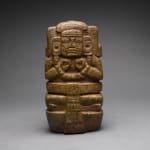Mayan Green Stone Figure, 300 CE - 900 CE
Jade
height 19.1 cm
height 7 1/2 in
height 7 1/2 in
DK.133
Further images
The spectacular royal figure portrayed here has his arms folded across his chest in the attitude typical of Mayan kings, holding the ceremonial bar with its two serpent heads. This...
The spectacular royal figure portrayed here has his arms folded across his chest in the attitude typical of Mayan kings, holding the ceremonial bar with its two serpent heads. This version of a scepter, very common in monumental iconography, symbolizes the sky, which the king must maintain in its place. Here the scepter is absent, and the arms are folded over a magnificent necklace of heavy pearls. The belt has a decoration of crossed bands, also celestial symbols, retaining an apron with pendants. The lower face of the figure is framed by scroll motifs, and his barbells, like his clearly visible incisors, are typical of several divinities. He wears broad ear spools and his forehead is marked with a double bar and four roundels, possibly references to the axis mundi and the cardinal points. The magnificent headdress consists of the head of an ajaw (lord) and some foliage. There may be a connection here with the Foliated Ajaw, a mysterious figure active in Copan (Honduras) in the early and late Pre-Classical periods. This phenomenal statuette of great importance resembles items discovered in caches of offerings in Copan, as well as certain stelae on the site, making it highly probable that it originates from there.
For a related and extremely similar statuette see “Masters of the Americas” In Praise of the Pre-Columbian Artists, The Dora and Paul Janssen Collection. (p.101)
Re Toubia
For a related and extremely similar statuette see “Masters of the Americas” In Praise of the Pre-Columbian Artists, The Dora and Paul Janssen Collection. (p.101)
Re Toubia







